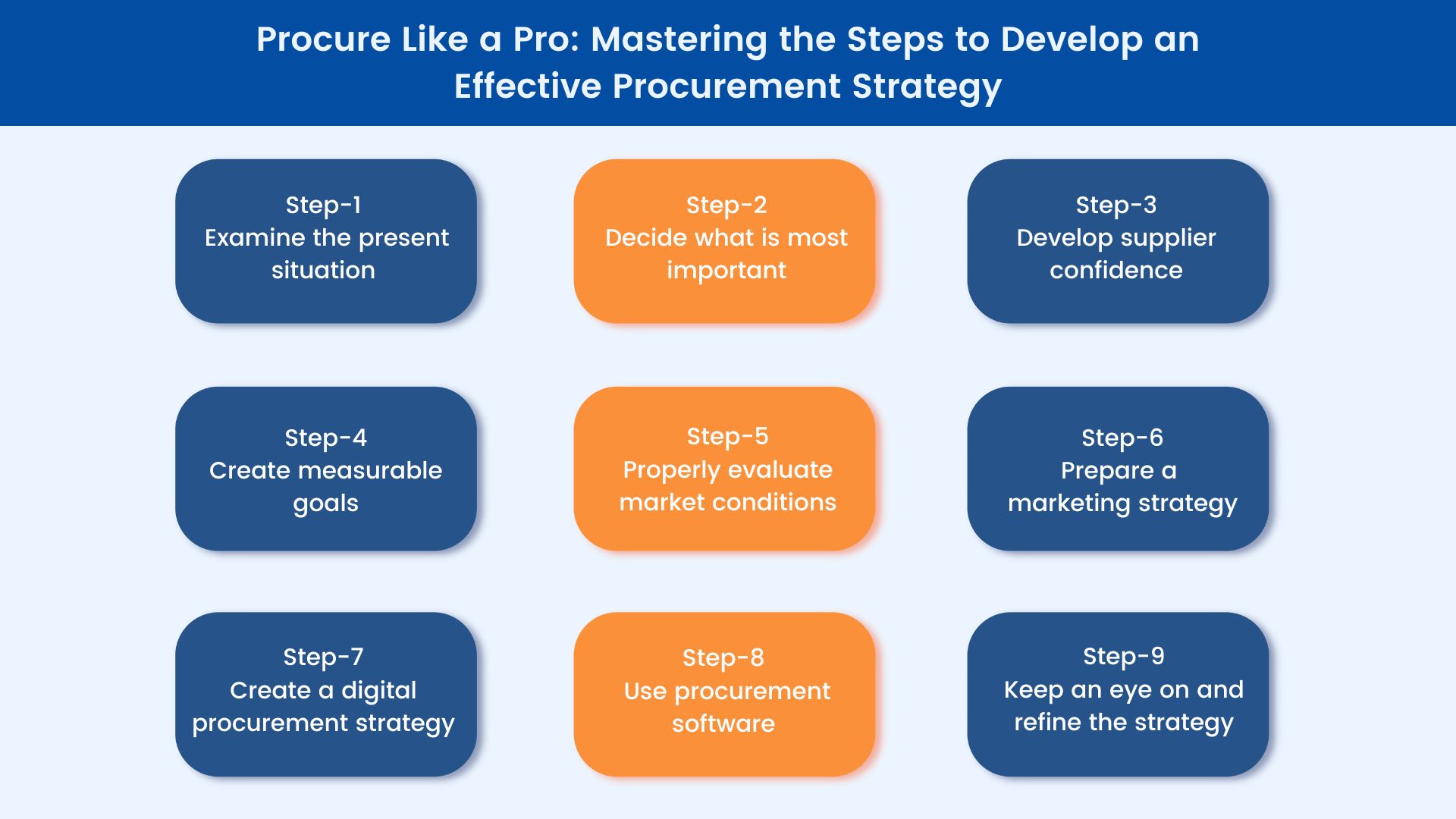
With the vast array of technology solutions available, it can be daunting to find out where to begin. However, with a solid digital procurement strategy in place, businesses can gain a competitive edge, streamline their operations, and achieve significant cost savings.
As businesses continue to embrace digital transformation, procurement processes have become an integral part of the change. With the increasing availability of technology solutions, companies now have the opportunity to build a solid digital procurement strategy that can drive operational efficiency, cost savings and improve supplier relationships. However, the challenge lies in developing a comprehensive plan that addresses your organization’s unique needs. In this blog post, we’ll explore nine simple steps you can take to build a solid digital procurement strategy that will help your organization achieve its goals and stay ahead of the competition.
What is a Procurement Strategy?
The phrase “procurement strategy” describes a long-term plan to establish friendly relations with competing companies in order to obtain the required goods and services of the highest quality within a given price range and have them delivered on a timeline.
A procurement strategy outlines the requirements used to make purchases. It is a general term that covers various procurement cycle processes.
Budgets and practical steps are outlined in winning Digital Procurement Strategy is based on internal analysis and outside observations.
Based on information about vendors, the market, pricing, and other important factors, strategic procurement assists in deciding which products or services to choose, from which suppliers, and how much to pay.
Benefits of an Effective Procurement Strategy
A digital procurement strategy must be supported by management and implemented by all buyers in your organization.
Without it, you may struggle to keep costs under control, deliver consistently high-quality goods and services, and ensure the availability of the products and services you require to run your business.
- Determine which expenses, categories, and commodities require greater control.
- Locate dependable supply sources.
- Define a clear supply chain management policy and widely promote it.
- When people do not follow the process, there should be consequences.
- Obtain the support of all stakeholders, which would include senior management.
- It requires the procurement process to be monitored in order to determine how actual performance compares to planned activities and thus to alert relevant departments and adjust the procurement plan accordingly.
- It improves the procurement process’s transparency and stability
Also Read: Digital Transformation Statistics and Trends To Help You Navigate
Types of procurement strategies
Every business is different, necessitating the implementation of customized procurement strategies.
However, various types of procurement strategies can be adapted and implemented by organizations of all sizes.
1. Unify the supply chain
There are various approaches that can be used to achieve the goal of improving procurement performance.
Some businesses choose to focus on reducing costs and spending. Others, on the other hand, decide to concentrate on improving the invoicing process.
The procurement strategy should always try to enhance the flow of whole procurement chain, from finding new suppliers to paying invoices.
2. Risk management
A high-pricing procurement strategy almost always involves taking risks. This level of risk is only acceptable to a business if the consequences of a potential supplier failure are limited to the supplied context. Any systemic risk to the company must be avoided at all costs.
A good strategy would be to test out a new supplier for a product that is very simple to obtain within a day.
However, doing so for a strategic supply during a peak production period is fraught with danger.
3. Worldwide sourcing
Global sourcing involves purchasing goods or services from suppliers all over the world. This can be a good option for companies looking for the best possible purchase price.
Global sourcing can also assist businesses in mitigating risks by diversifying their supplier base. It also enables businesses to enter new markets and discover innovative products.
4. Procurement Training
This strategy may be one of the most important, given the constant evolution of procurement practices and techniques.
However, any procurement strategy must be implemented by people, and if the staff lacks the necessary training and skills, the strategy’s delivery may be jeopardized.
5. Eco-friendly purchasing
Environmental responsibility is a strategy that focuses on purchasing goods and services with the least environmental impact.
This can include items made of recycled materials, those with low emissions, or items that use less energy. Businesses that want to reduce their environmental impact and operate more sustainably should consider green purchasing.
Also Read: Expert Strategies to Master Top 10 Project Management Challenges
Procure Like a Pro: Mastering the Steps to Develop an Effective Procurement Strategy
Strategic thinking and a focus on outcomes are the foundation of a successful procurement strategy.
It targets operational excellence while taking into account the increasingly complex nature of business environments.

Follow these nine steps to create digital procurement solutions.
1. Examine the present situation
Companies must first determine what aligns with their company’s objectives before developing a digital procurement strategy.
They should be aware of their future needs and identify key areas for improvement. To accomplish this, businesses must understand their operations’ risks and market position.
Identifying risks entails taking into account a variety of factors, such as market maturity, market capability, and political opportunities, as well as risks and stakeholder management.
2. Decide what is most important
After critically evaluating the situation, it is critical to document the drivers and the link between the procurement strategy and corporate goals.
Strategic drivers differ greatly between industries. As a result, firms should first gather information about corporate goals before mapping procurement objectives to each.
3. Develop supplier confidence
Suppliers are not only an essential component of businesses, but they also play an important role in increasing operational and cost efficiencies.
Building team credibility and trust will assist businesses in dealing with high-volume or last minute demands, as well as the successful implementation of a procurement strategy.
As a business, you must be fair to your suppliers and ensure that they are paid on time.

4. Create measurable goals
Although increasing sales remains one of the primary goals for businesses, companies must be more specific when developing a procurement strategy.
They should be able to tell whether the goals they set are specific and measurable.
Providing a consistent tool for tracking key metrics related to the procurement strategy can be an effective way for organizations to track their progress over time.
5. Properly evaluate market conditions
Before you dive into digital procurement, it’s critical to understand what’s going on in your industry and the broader market.
The best way to accomplish this is to conduct a competitive analysis. This process entails gathering information about your competitors (including their strengths and weaknesses) so that you can identify areas for improvement.
If you lack the time or resources to conduct an in-depth competitive analysis, begin with a high-level overview of how other companies are implementing digital procurement strategies.
6. Prepare a marketing strategy
Plan your market approach before implementing your strategy. This includes determining the best tender process, identifying the best pricing mechanism, and deciding on the type of contract needed for a specific project.
Companies can choose the type of contract based on the delivery model, nature of the work, risk profile, and anticipated timeframe for delivery to ensure high-quality and cost-effective outcomes.
7. Create a digital procurement strategy
It is now time to conduct a strategy based on the information gathered in the previous steps.
Describe the current situation, list strategy objectives, and develop a tactical plan to achieve these objectives.
When developing a procurement strategy, make sure to set SMART goals. Every objective should be:
- Specific
- Measurable
- Assignable
- Realistic
- Time-related
8. Use procurement software
The procurement process is quite complex, with multiple steps that must be followed precisely.
As a result, if an appropriate digital solution is not implemented, there is a significantly increased risk of error.
Procurement software is critical for eliminating manual data entry, reducing errors, streamlining administrative tasks, and increasing employee productivity.
Furthermore, automation makes the procurement process less time-consuming, less prone to error, and more cost-effective.
9. Keep an eye on and refine the strategy.
The final step in developing a digital procurement strategy is to put it into action.
The key to success is to ensure that you have all of the necessary people on board and that they understand their responsibilities.
As you carry out your strategy, remember that it is never too early or too late to make changes, no matter how minor, as long as they align with your objectives.
It’s critical to keep track of your progress so that you can address any issues before they become major issues.
Conclusion
Creating a successful procurement strategy is a multi-faceted chain process that demands careful planning, attention to detail, and the ability to adapt to dynamic circumstances in transforming in digital-first organization. By following a step-by-step approach, businesses can assess their current procurement practices, identify areas for improvement, set realistic goals, and create a comprehensive roadmap to achieve them. A well-designed procurement strategy can result in increased efficiency, cost savings, better supplier relationships, and a competitive advantage in the marketplace. With the right mindset, resources, and tools, businesses can navigate the complexities of procurement and build a strategy that delivers tangible benefits for their organization.
Frequently Asked Questions(FAQs)
Q. What is digital procurement, and why does it matter?
Digital procurement is using technology and data to streamline and enhance the procurement process. It matters because it significantly improves efficiency, cost savings, and transparency in sourcing goods and services, ultimately boosting a company’s competitiveness in a digital-first business landscape.
Q. What are the benefits of digital procurement?
Digital procurement offers advantages such as cost reduction, faster procurement cycles, improved supplier relationships, enhanced data-driven decision-making, and increased compliance with regulations.
Q. How can businesses begin their digital procurement journey?
To start, businesses should assess their current procurement processes, identify areas for improvement, select appropriate technology solutions, and develop a clear implementation plan.
Q. Which technologies are crucial for digital procurement success?
Key technologies include e-procurement software, spend analytics, supplier management tools, and AI-powered solutions for predictive analytics and automation.
Q. What are the challenges of digital procurement?
Challenges may include resistance to change, data security concerns, and integration issues. Companies should invest in change management, robust cybersecurity measures, and seamless system integration during their digital procurement transformation to overcome them.
Login
Please login to comment
0 Comments
Oldest
















